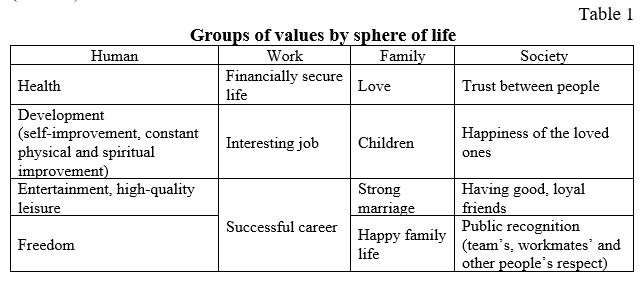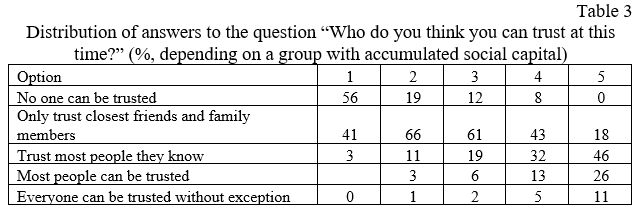Ценности и социальный капитал российского регионального сообщества
Aннотация
Преобразования современной социальной реальности актуализируют внимание на понимании происходящих процессов в современном глобализирующемся мире, что позволяет ученым заявлять о глубинном цивилизационном сдвиге. При этом, процессы, которые мы наблюдаем, затрагивают саму сущность ценностных оснований человеческого сообщества. С эволюцией общества происходило расширение и углубление представлений о его ценностной системе. Современное российское общество представляет собой достаточно противоречивый конструкт, основанный на разнообразных, порой противоречащих друг другу ценностных основаниях. Являясь основой социальных отношений, ценности служат базовым основанием формирующегося в сетях этих отношений социального капитала. Исследовались связи и зависимости выбора респондентами той или иной ценности от уровня накопленного социального капитала. В исследовании использовались авторская методика определения уровня накопленного социального капитала на основе его интегрального индекса. Методика позволила измерить уровень накопленного социального капитала в регионе и показать его распределение среди носителей. Исследование показало снижение интегрального индекса социального капитала в следствие пандемии, приведшей к ограничениям социальных связей. Опираясь на разработанный М. Вебером метод «отнесения к ценности» или придания значения, был определен перечень ценностей, характеризующих основные сферы жизнедеятельности индивида, выявлены отрицательные и положительные связи между выбором респондентами ценностей и их принадлежностью к группе с накопленным социальным капиталом. Исследование выявило ряд проблем, требующих дальнейшего изучения.
Ключевые слова: ценности, регион, социальный капитал, индекс социального капитала, метод «отнесения к ценности»
К сожалению, текст статьи доступен только на Английском
The role and significance of values in the life of society are extremely vital. They largely explain the changes taking place in the society. Crisis phenomena can lead to their revaluation, shift the course of value development, as well as give rise to a shortage of established values shared by many or most people in the society. According to data obtained by ZIRCON Research group during the implementation of the project "Value Solidarity and Public Trust", Russian society appears to be a very complex and contradictory construct[1].
Values as a research topic are currently becoming more and more relevant. It is also highly important to study values, value attitudes, and their systems comprehensively due to the need to find ways to influence them in order to prevent conflicts in the society and re-focus on positive goals. Estimations that the former values lose their functional purpose are most often "unsubstantiated statements" (Parsons, 2018).
Representing a concentrated expression of accumulated historical experience and cultural heritage of any ethnic group, values serve as guidelines which bring individuals’ actions to correlation. Values are a social product, the result of vital activity of a society or a social group. Researchers believe that only a value that is recognized and serves as a reference point of behavior is of certain significance for an individual. M. Rokeach defines value as «an enduring belief that a specific mode of conduct or end-state of existence is personally or socially preferable to an opposite or converse mode of conduct or end-state of existence” (Rokeach, 2015: 305).
The values prevailing in the society serve as a functional indicator for analyzing personal and cultural changes as a response to historical and social changes. This explains such attention to them from the world research community, as well as the availability of various research methods. The best known are studies by G. Hofstede, which identified the correlation between values and the level of economic and political development (Hofstede, 2001). Inglehart’s research found significant differences in the value systems of countries depending on the level of their democratic and economic development (Inglehart, 1997). Schwartz’s survey also analyzed the relations between value systems and economic performance. (Schwartz, 2004: 43-73). These studies also shed light on Russia. For example, according to Hofstede’s survey, the country is characterized by average values (Hofstede, 2001). According to Inglehart, Russia, while being closer to the pole of survival, is rather rationalistic (Inglehart, 1997). According to the Schwartz Scale of Values, it is currently located at the intersection of Embeddedness, Hierarchy and Mastery (Schwartz, 2004). The developed methods were also used by Russian researchers. For example, according to the results of the study on Schwartz measurements published in 1999, Russian students demonstrated higher value indicators compared to those from both Eastern and Western Europe (Lebedeva, 1999).
All these studies show a significant impact of social factors reflecting people’s relationships in certain socio-economic conditions on the development of a society. It turns out that cultural traditions and value attitudes greatly influence social capital (Lebedeva, Tatarko, 2010). Therefore, the study of the relationship between values and social capital in a territorial community is of particular research interest for the present study.
Theoretically, the purpose of the article is to identify the relationship between values and social capital. Methodologically, the purpose is to test the developed methodology for constructing an integrated index of social capital in order to identify the value preferences of its carriers depending on belonging to a particular group of social capital. The empirical part involves identifying and studying the distribution of values depending on the respondents’ belonging to a group with accumulated social capital.
Methodology and methods. Over time, science has formed an understanding that all spheres of human life have a value basis. According to researchers, the interpretation of the category commonly includes “...characteristics that can be considered by an individual or public consciousness as socially significant and at the same time act as an element of a holistic positive image of the world” (Zemtsova, 2015: 136).
The category of value was introduced into sociology thanks to Max Weber and his theory of social action based on the thesis formulated within the framework of the neo-Kantian approach about the relations between the values which a person possesses and which indicate an individual’s codes of conduct and the goals of their activity with the possible interpretation of their actions. Weber also successfully applied the method of «value attribution». It was developed by H. Rickert, who represented the Baden school based on the neo-Kantian approach, which laid the methodological ground of the research. According to H. Rickert, “what cannot be attributed to values has absolutely no meaning” (Rickert, 1908: 100). In this context, values become absolute assessments of an ideal entity, the criteria of which lie beyond the limits of human activity. An entity free from values is at the same time devoid of meaning and value (Rickert, 1998: 336). An important aspect of this method is that it separates the concepts of “value” and “evaluation”. According to Rickert, their mixing is a kind of “a disease” of scientific knowledge. “The problem of value is the problem of “value significance” (Geltung), and this issue doesn not coincide with the issue of the existence of evaluation" (Rickert, 1998: 459). This approach helped Weber determine the meaning of an action focused on value through its nature rather than its goal as such, since it is value that is its basis (Weber, 1990).
The ideas of value have evolved with the development of philosophy from epoch to epoch. This was accompanied by the understanding of new emerging values generated by new historical stages of human social development. The researchers note that the category of value enriched “from the ethical and aesthetic to the ontological, epistemological, methodological and instrumental meaning of this concept” (Fedorov, Blagova, 2016: 137).
As a basis of human relations values are closely connected with social capital, which derives from the established social relations in the society. According to G. V. Rozhkov, this connection is caused by the fact that “social capital is transmitted and reproduced through historical and cultural mechanisms such as traditions, agreed standards and values” (Rozhkov, 2009: 244). Being social in its origin, social capital depends on the intensity and nature of people’s relations people, which, in turn, are based on the socially established system of values.
The concept of social capital originally comes from economic studies. R. Putnam and J. Helliwell’s comparative analysis of the economic development of regions in Italy helped them understand the role of social relations in economic development (Putnam, Helliwell, 1995).
In further research, R. Putnam connected social capital with trust, standards, networks of relations between people, and showed its ability to influence the coordination of actions. He sees the basic essence of the theory of social capital in recognizing the value of networks of relations for the influence of contacts on efficient interaction between subjects such as individuals, groups, or organizations (Putnam, 2001). According to Putnam, public life, expansion of contacts and connections, as well as development and consolidation of standards of interaction are the indicators of presence of social capital.
P. Bourdieu deepens the understanding of social capital, including it into the system of aggregate capital (Bourdieu, 2002). Bourdieu revealed the significant difference between social capital and the previously known forms of aggregate capital, pointing out that the latter is intangible. This is due to its different nature. Social capital can only arise in the process of interaction and exchange between people. According to Bourdieu, one of the significant conditions for the emergence of social capital is joining a group, which helps acquire “support in the form of collective capital, “reputation”, which ensures loans in all senses” (Bourdieu, 2002: 66). Bourdieu believed that being a member of a group is associated with a certain position or status in the social structure (Bourdieu, 2001). A distinctive feature of social capital (in comparison with other forms of capital) is absence of ownership rights, which stems primarily from its nature as a public good. Being formed in networks of relationships, it is the "property" of all network participants (Guzhavina, 2018).
Currently, the study of social capital is conducted on the basis of national data (Callois, Schmitt, 2009; Dzialek, 2014) and international comparative studies (Knack, Keefer, 1997; Panebianco, 2003).
In our opinion, an important distinguishing feature of social capital is its territorial characteristic since owners of this resource have a certain connection to the territory of their residence (Guzhavina, 2020). This explains the nature of social capital as a “local” product (Polishchuk, Menyashev, 2011).
In the present research, social capital is referred to as networks of social relations based on trust and characterized by common standards, values, and the level of people’s involvement in them; as external effects and results generated by social interaction within these networks and associations that are useful for the society and social groups (Afanasyev, Guzhavina, Mekhova, 2016).
Further analysis is based on the following points. First, social capital is embodied in social relations created by subjects in the process of interaction and social exchange. Second, as social capital is of social nature, its most important structural element includes values affecting the reproducibility of the phenomenon under study. When we speak of values, we refer to Weber’s approach of “value attribution”. Third, social capital, being a public good, is formed in networks of interaction, and the subjects of interaction act as its carriers, rather than its owners. And finally, carriers of different amounts of social capital differ in their set of values and their rank distribution.
Research methodology. The analysis of social capital of the regional community is based on the method of an indicator model for measuring social capital, which was developed with participation of one of the authors of the present research. The model is based on the index method. This method helps calculate the integrated index of social capital for each respondent using around 49 indicators classified into groups according to 3 main categories defined as “Trust”, “Networks”, and “Values”. “Trust” includes indicators aimed at measuring interpersonal, institutional and general trust. The group “Networks” includes indicators measuring people’s inclusion into networks of relations. “Values” include indicators measuring basic values such as locus of responsibility, attitudes of solidarity and readiness to unite, self-assessment of opportunities to influence the situation at different levels of life (from family to country).
The integrated index of social capital (ISC) is calculated using the formula that includes the main components of social capital: trust, networks, values and standards.

Based on the obtained data, groups of carriers of social capital are determined depending on the level of its accumulation. The next step was grouping, which made it possible to distinguish groups of carriers of social capital depending on the level of its accumulation. Respondents with the lowest level of social capital, who mostly choose options such as “I do not trust”/ “I did not participate” / “I cannot influence in any way”, etc. when answering questions, are classified to the first group – a group with minimal social capital. The second group includes respondents with a higher index referred to as carriers of low-level social capital. Their answers were also dominated by points such as “I don't trust”/ “I didn't participate” / “I can't influence in any way”, yet there were also positive alternative options. The third group includes respondents with average social capital. Respondents give a lot of positive answers, which results in higher index values. This group turned out to be quite numerous. The fourth group includes those who demonstrate a relatively high-level social capital. This group is characterized by positive attitudes towards trust, readiness to unite or be part of public life, they demonstrate a pronounced internal locus of control. Quite few respondents with high-level social capital are included in the fifth group. Carriers of high-level social capital do not only have positive alternatives to “trust/participate/influence” in the structure of responses, but also say that they are involved in social activities or are initiators of collective actions, etc. They have a wide range of contacts, they are not only ready, but really use their resources, they are focused on achieving socially significant goals.
The methodology is described in more detail in the collective monograph “Regional Social Capital in the Conditions of Crisis”, which describes the results of the study conducted by a research team in the framework of the project financially supported by the Russian Foundation for Basic Research (grant no. 16-03-00188-OGN) (Regional Social Capital..., 2018).
The empirical basis of the research includes data obtained during the implementation of the Russian Foundation for Basic Research (RFBR) grant No. 20-011-00326 “Collective Actions and Social Capital in the Russian Society” in 2020. The survey was carried out in the cities of Vologda and Cherepovets, as well as in 8 districts of the Vologda Oblast. The representativeness of the sample was ensured by quotas based on gender and age according to the existing structure of the adult population in the cities participating in the survey. Sample size – 1,918 people.
Research Results and Discussion. Using available data and the research model we analyzed the distribution of social capital among the residents of the Oblast. The research shows that low-level and average social capital, or Types 2 and 3 according to our classification, prevail in the Oblast (Fig. 1).
 It is noteworthy that a significant decrease in the level of social capital was revealed under the influence of the pandemic. According to the 2018 research based on the same methodology, the predominant types in the region were Type 3 and 4. (Regional Social Capital…, 2018) Self-isolation, limited contacts and connections were the factors that decreased the level of social capital in the community. On the other hand, we once again confirmed the fact that social capital is a product of social relations and is generated in the networks of these relations.
It is noteworthy that a significant decrease in the level of social capital was revealed under the influence of the pandemic. According to the 2018 research based on the same methodology, the predominant types in the region were Type 3 and 4. (Regional Social Capital…, 2018) Self-isolation, limited contacts and connections were the factors that decreased the level of social capital in the community. On the other hand, we once again confirmed the fact that social capital is a product of social relations and is generated in the networks of these relations.

We view social capital as an integrated index, so the analysis of its constituent indicators helps better understand its distribution and the situation in the territorial breakdown.
As a product of social relations, social capital is not only based on values available in the society, but also contributes to the production of those supporting trust and promoting solidarity (P. Bourdieu). Moreover, social capital available to an individual or group affects the formation of attitudes, and consequently, behavior practices in various spheres of life. One of the goals of the present research was to study value attitudes of the population in the Vologda Oblast depending on the level of accumulated social capital relative to the main spheres of human activity.
The set of values presented is formed based on Rokeach’s methodology and Weber’s approach. The list of values offered to the respondents included those characterizing the main spheres of human life – work, family, social relations, as well as values that create conditions for individual existence and self-fulfillment (Table 1).

Below is a brief description of each of the selected groups of values that characterize the main spheres of life depending on their distribution in groups of carriers of social capital.
The first group includes values that are important for people’s individual existence. It is conventionally designated as a semantic value group “Human”. The absolute value here is physical health. The aspects of possible development, self-improvement, constant physical and spiritual improvement are also important. It is essential for a modern person to use their free time efficiently as it helps them develop their creative abilities. These indicators are closely related to the respondents’ perception of freedom, which provides opportunities in various spheres, including participation in solving significant public issues.
The second group “Work” is related to working activity and includes characteristics of the financial situation, attitude to work and career. It is noteworthy that for the majority of Russians (it is them who make up the group of people who become respondents in surveys) work is the main or the only source of income and, accordingly, financial well-being. An interesting job and a successful career do not only help individuals fulfill themselves, but also increase the level of their well-being.
The third group “Family” characterizes the sphere of family relations. Family is the environment where an individual is formed and where they realize their human potential and provide future generations. Family values include love, a strong marriage, a happy family life, and children.
The fourth group “Society” includes values related to individuals’ interaction in the social environment. Social relations, representing the basis of the society, are not always realized and are taken for granted. But they are impossible without trust.
Further analysis of value attribution of a particular indicator will be conducted based on this distribution. During the survey, respondents ranked values according to the degree of their significance on a 10-point scale (Table 2).

In further research, values were correlated with groups of respondents who carried social capital of different types (Fig. 2).

It is important that all respondents ranked confession as the least significant value. In this respect, our research results fully coincide with those obtained by the researchers of the ZIRCON Research group[2]. This value is excluded from further analysis. The rank of health as a value is quite understandable. In is ranked as the most important by carriers of all types of social capital.
Values are distributed rather unevenly among the carriers of social capital at different levels (Fig. 1). For comparison, consider the situation with with two opposite groups of carriers of minimum and maximum indicators of the integrated index – the first and fifth groups. This comparison most clearly shows the possibilities of the methodology for identifying and describing the structural characteristics of a territorial community.
Respondents with minimal social capital demonstrate almost minimal indices of value attitudes. Among them, those having individualistic aspirations and minimal focus on public interests are at a higher level. They are not interested in personal development, creativity-focused leisure or career. Only 48% of them believe that an interesting and busy life depends on them. To compare, the share of respondents who chose this alternative is about 90% in the fifth group. The representatives of this group are more focused on family, happiness of the loved ones. This once again confirms that they are concentrated on the inner circle, where trust is mainly demonstrated towards relatives, less often towards friends or colleagues. These respondents have a very narrow trust range (Table 3). We have repeatedly noted this sustainable aspect (Guzhavina, Vorobyova, 2018; Guzhavina, Silina, 2018).

Trust among the representatives of the fifth group is at a much higher level, which helps them build wider networks of relations. Trust is the most important factor for the formation of social relations, the basis for the stability and integration of society (Shabunova, Guzhavina, Kozhina, 2016).
An indicator of involvement in the system of public relations and the presence of networks where social capital is generated can be the respondents’ answers to the question “Do you belong to any public organizations or participate in any events or actions hosted by them?”. Respondents of the first group give negative answers (92%), while 86% of those from the fifth group answer positively.
The attitudes in labor relations in the fifth group are contradictory. The group of values "Labor" characterizes the respondents’ opinions regarding labor relations. This is a significant sphere as it provides stable social relations, which serve as the basis for the formation of an individual’s social identity. With unstable employment, the spread of short-term and transitional forms of employment, and increased pandemic restrictions, modern world creates risks of losing social identity obtained through labor. This issue of the modern world was addressed by the International Labour Organization[3]. The representatives of the fifth group certainly strive for financial well-being, yet they do not directly associate it with career and an interesting job. This is also confirmed by the fact that about half of the representatives of this group believe that “each person who can and wants to work is able to provide their financial well-being”, while in the fifth group, this opinion is supported by more than 80% of respondents. The difference in the respondents' self-assessment of their financial situation is also significant. In the first group, 5% of respondents rate their own and their family’s financial situation as good, in the fifth group – 21%. At the same time, an external locus of control is clearly observed in the first group, while in the fifth group it is internal. The willingness to take responsibility for the state of affairs is directly dependent on the level of accumulated social capital
The representatives of the group with high-level social capital demonstrate a more even distribution of attitudes in various spheres of life.
Conclusions. The analysis of theoretical and methodological approaches to the study of social capital and its impact on the basic values of the population of the region, as well as the results of the research conducted according to the author's methodology help us draw the following conclusions.
First, social capital should be considered as a dynamic resource. Its interpretation as a system of social relations explains the changes in the level of its accumulation and distribution between groups of carriers. It is obvious that changes occur under the influence of external factors. In our case, there was a decrease in the level of social capital in the period from 2018 to 2020 under the influence of pandemic restrictions. Second, Weber’ approach of "value attribution" showed its heuristic capabilities and demonstrated certain connections between the existing social capital and value attitudes. This is especially evident when comparing diametrically located groups of respondents according to the criterion of social capital accumulation. Value attitudes of carriers of high-level social capital are more evenly distributed. All intermediate groups have certain deviations that reflect the dynamics of transformation of value attitudes, depending on social capital at their disposal. Third, the results of the study provide an idea about the structuring of a territorial community, about the distribution of value attitudes characterizing various groups of carriers of social capital. This, in turn, can become the basis for understanding the purpoces for the activity of certain groups in the social or labor sphere, as well as for identifying the reserves of a social organism
[1] Value Solidarity and Public Trust in Russia. Available at: http://doverie.zircon.tilda.ws/ (Accessed: 20.07.2021).
[2] Value Solidarity and Public Trust in Russia. Available at: http://doverie.zircon.tilda.ws/
[3] The future of work centenary initiative. Report of Director General. International Labour Conference 104th Session, 2015. pp. 5-6. Available at: https://www.ilo.org (Accessed: 05.05.2021)
Благодарности
Статья подготовлена при финансовой поддержке РФФИ-РНФ в рамках научного проекта № 20-011-00326 «Коллективные действия и социальный капитал в российском обществе».


















Список литературы
Antonenko, I. V. (2015), “The essence of trust as a socio-psychological phenomenon”, Bulletin of the Ural Federal District, (3), 34-44. (in Russian)
Afanasyev, D. V., Guzhavina, T. A. and Mekhova, A. A. (2016), “Social capital in the region: on the issue of measuring and constructing an indicator model”, Economic and social changes: facts, trends, forecast, (6), 110-125. (in Russian)
Bourdieu, P. (2001), Practical sense, Aleteya, Saint Petersburg, Russia. (in Russian)
Bourdieu, P. (2019), “Forms of capital”, Economic Sociology, 3 (5), 60-74, Available at: www.ecsoc. msses.ru (Accessed 12 July 2019). (in Russian)
Weber, M. (1999), Selected works, Moscow, Russia. (in Russian)
Guzhavina, T. A. (2018), “Social capital of the urban community: trust, solidarity, responsibility”, Economic and Social Changes: Facts, Trends, Forecast, 11 (2), 225-230.
Guzhavina, T. A. (2020), “Social capital of the population of small towns”, Materials of the X International Sociological Grushinskaya Conference “To live in Russia – to live in the world. Sociology of everyday life”, 2020, Moscow, Russia, 191-195. (in Russian)
Zemtsova, E. (2015), “In the Ontological prerequisites for the study of value as a socio-philosophical category”, Socio-Humanitarian Knowledge, (6), 127-143, (in Russian)
Losskii, N. O. (1931), Value and being. God and the kingdom of God as the basis of value, YMCA-PRESS, Paris. (in Russian)
Plato. Laws, available at: https://www.gumer.info/bogoslov_Buks/Philos/Platon/zakon.php (Accessed 05 May 2021) (in Russian)
Polishchuk, L. and Menyashev, R. (2011), “The economic significance of social capital”, Economic Issues, (12), 46-65. (in Russian)
Guzhavina, T. A., Afanasyev, D. V., Vorobyova, I. N. and et al. (2018), Regional Social Capital in the Conditions of Crisis: monograph, Cherepovets State University, Cherepovets, Russia. (in Russian)
Rickert, G. (1998), “On the concept of philosophy, the Philosophy of life”, “Nika-Center”, “Vist-S”, Kiev, Ukraine. (in Russian)
Rozhkov, G. V. (2009), “Genesis of the innovative economy in Russia”, in Eroshenkov, S. G. (ed.), Moscow, Russia. (in Russian)
Fedorov, V. A. and Blagova, A. S. (2016), “Evolution of the concept of "Value"”, Bulletin of the RUDN. Series: Philosophy, (1), 128-140. (in Russian)
Shabunova, A. A., Guzhavina, T. A. and Kozhina, T. P. (2016), “Trust and Social Development in Russia”, Problemy razvitiya territorii, (2), 7-19.
“Value solidarity and public trust in Russia”, Available at: http://doverie.zircon.tilda.ws/ (Accessed 02 March 2021). (in Russian)
Callois, J. M. and Schmitt, B. (2009), “The role of social capital components on local economic growth: Local cohesion and openness in French rural areas”, Review of Agricultural and Environmental Studies, (90), 257-286 (in Russian)
Dzialek, J. (2014), “Is social capital useful for explaining economic development in polish regions?”, Geografiska Annaler: Series B, Human Geography, 96 (2), 177-193.
Putnam, R. D. (2001), Bowling Alone: The Collapse and Revival of American Community, Touchstone Books by Simon & Schuster, New York, USA.
Putnam, R. and Helliwell, J. (1995), “Economic Growth and Social Capital in Italy”, Eastern Economic Journal, (21), 295-307.
Panebianco, S. (2003), The impact of social capital on regional economic development, ACSP Congress, Lovanio.
Svensen, G. T. and Svenddsen, G. L. H. (eds.) (2009), Handbook of Social Capital: The Troika of Sociology, Political Science and Economics, Edvard Elgar, Northampton, MA.
The future of work centenary initiative, Report of Director General, International Labour Conference 104th Session, 2015, 5-6, Available at: https://www.ilo.org/ (Accessed 05 May 2021)